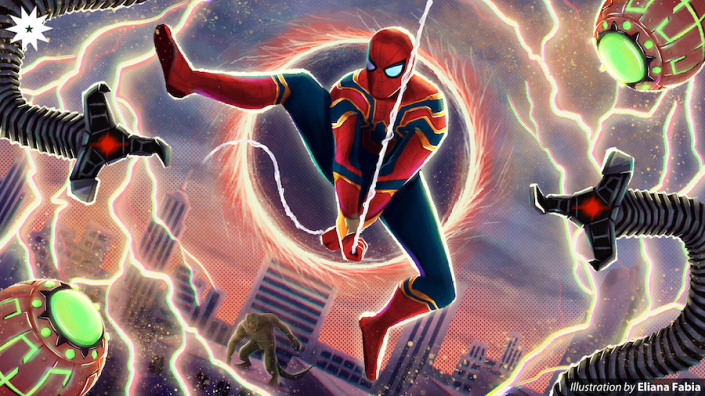The Marvel Cinematic Universe (MCU) has gradually teased about exploring the multiverse in its canon. While several MCU films and TV series dabbled with the idea, it was Doctor Strange who established the multiverse. But Benedict Cumberbatch’s Sorcerer Supreme isn’t the focus for when this is introduced but our friendly neighborhood Spider-Man. Indeed, Spider-Man: No Way Home involves the wide expanses of the multiverse, but it also grounds itself to keep the premise personal.
While villains from Sam Raimi’s trilogy and Marc Webb’s Amazing Spider-Man movies band together to face off against the heroic webslinger, Tom Holland’s Peter Parker not only deals with baddies unknown to him. In the film, Peter also learns about taking accountability for his actions in his monomyth—something that seemed absent in his past two movies. Holland’s third standalone MCU film delves deeper into what made the original trilogy profound: the dichotomy of Peter Parker and Spider-Man.

The birth of Spider-Man
In the past two films, audiences see glimpses of Peter’s personal life intertwined with his being Spider-Man. Often, these scenarios were used for comedy. But in this film, Holland presents a different side of Peter, giving even more depth to the quirky and nerdy teenager. His growth from being a naive high school student who hid his double life to becoming a powerful and responsible superhero feels poetic. His portrayal allows audiences to discern the gravity of his mission and to somehow bear the weight of Peter’s consequences on their shoulders, too. More importantly, this box-office hit focuses solely on Peter and his future. Instead of hanging onto Iron Man and the core Avengers, Peter now faces his own enemies and problems himself.
This constant internal struggle is what makes Spider-Man who he is. This lack of a central idea was what made the MCU’s past two Spider-Man films lackluster compared to Raimi’s and Webb’s movies. He may have been defeating bad guys, but behind the mask was someone who did not realize the implications of his actions. It was as if when he was Spider-Man, the noble Peter Parker was an entirely different entity.
This prompted a much needed character study on Holland’s interpretation of the beloved superhero. Spider-Man: No Way Home begins where Far From Home left off. With Peter’s dual life ruptured, he seeks help from Doctor Strange who conjures the Runes of Kauf-Kaul—a memory-wiping spell. However, the spell goes awry due to Peter’s disruptions, mostly due to his insistence on keeping his loved ones in the know. This resulted in the fracturing of the fabric of space-time.
This meeting with Doctor Strange shows Peter’s inability to accept the consequences that come with being Spider-Man. Such a premise highlighted the recurring theme: hinging on Peter’s choices and decisions.
By the end of the film, Peter has emancipated into the hero he wants to become. It is at this point that Peter finally becomes Spider-Man, where he realizes that the power he holds comes with a duty that he should not, and cannot neglect.
Fan-favorite comebacks
Still by Peter’s side are Jacob Batalon’s bumbling Ned Leeds and Zendaya’s spunky MJ Watson. While their relationship with Peter was greatly established since Spider-Man: Homecoming, this film furthers their dynamics, showing how the trio works together while facing dire situations.
Zendaya and Batalon’s performances are all too relatable. Their sarcasm and quips give Peter’s tense journey much needed icebreakers. The sincere friendship between the three is palpable and seems genuine, leaving audiences wishing for the same bond in their circles.
Even Cumberbatch shows an array of emotions as he faces internal conflict. Despite every attempt to help the teenage hero, Doctor Strange’s strong demeanor eventually falters—contradicting his usual confident and calm demeanor.
But what treats fans of the superhero franchise are the appearances of villains from Raimi’s Spider-Man and Webb’s The Amazing Spider-Man universes: Willem Dafoe’s Green Goblin, Alfred Molina’s Doctor Octopus, Thomas Hayden Church’s Sandman, Rhys Ifans’ Lizard, and Jamie Foxx’s Electro. Each actor portrays their respective villain phenomenally—as if the Spider-Man and The Amazing Spider-Man films came out just yesterday. Dealing with the confusion of being dragged into a universe different from their own, the villains show a somehow more vulnerable side of their personas. In a way, they remind audiences that they’re just as human as others, despite their reputations.
Opening a multiverse
Much like the other films in the MCU, Spider-Man: No Way Home does not shy away from its dynamic fight scenes. Though the computer-generated imagery seems like it still needs more time in the oven, the film delivers breathtaking set pieces that may not have been possible when the villains first appeared on the big screen.
In between all the web-slinging and fistfights, the film shows the different sides of our favorite characters, allowing audiences to relate and empathize with them. The movie also banks heavily on nostalgia by bringing back old villains. Even if audiences have not watched any of the previous Spider-Man franchises, they will still enjoy the film. But for those who have, the satisfaction of such a culmination of storylines is much greater.
Spider-Man: No Way Home takes one on an amazing journey throughout the haunting boroughs of the Big Apple with Peter Parker and his friends. With pacing that keeps audiences wondering about what happens next and who else will be appearing, each scene injects excitement through one’s veins and keeps the audience at the edge of their seats.
Spider-Man: No Way Home opens a multiverse of opportunities for the MCU. As the trilogy ends, it gives way for future MCU films to dive into multidimensional realms. But should we ever need a reminder, director Jonn Watts’ masterpiece teaches audiences that at the end of the day, great power comes with great responsibility.
